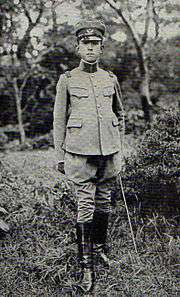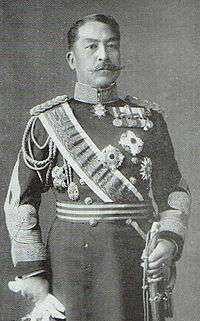Prince Kan'in Kotohito
| Prince Kan'in Kotohito | |
|---|---|
|
Prince Kan'in Kotohito | |
| Native name | 閑院宮載仁親王 |
| Nickname(s) | Prince messenger |
| Born |
November 10, 1865 Kyoto, Japan |
| Died |
May 21, 1945 (aged 79) Odawara, Kanagawa, Japan |
| Allegiance | Empire of Japan |
| Service/branch | Imperial Japanese Army |
| Years of service | 1881–1945 |
| Rank | Field Marshal |
| Commands held | |
| Battles/wars | |
| Awards |
|
Prince Kan'in Kotohito (閑院宮載仁親王 Kan'in-no-miya Kotohito Shinnō OM, November 10, 1865 – May 21, 1945) was the sixth head of a cadet branch of the Japanese imperial family, and a career army officer who served as Chief of the Imperial Japanese Army General Staff from 1931 to 1940.
Early years
Prince Kotohito was born in Kyoto on November 10, 1865 as the sixteenth son of Prince Fushimi Kuniye (1802–1875). His father was twentieth head of the Fushimi-no-miya, one of the four shinnōke, branches of the Imperial Family which were eligible to succeed to the throne if the main line should die out. Since the infant mortality rate in the main imperial household was quite high, Emperor Kōmei, the father of Emperor Meiji, adopted Prince Kotohito as a potential heir. Prince Kotohito was thus the adopted brother of Emperor Meiji and a great uncle to both Emperor Shōwa and his consort, Empress Kōjun.
Prince Kotohito was initially sent to Sambō-in monzeki temple at the age of three to be raised as a Buddhist monk, but was selected in 1872 to revive the Kan'in-no-miya, another of the shinnōke households, which had gone extinct upon the death of the fifth head, Prince Naruhito.
Marriage and family
On December 19, 1891, Prince Kotohiko married Sanjō Chieko (January 30, 1872 – March 19, 1947), a daughter of Prince Sanjō Sanetomi. The couple had seven children: five daughters and two sons:
- Prince Kan'in Atsuhito (篤仁王 Atsuhito-ō, 1894–1894)
- Princess Kan'in Yukiko (恭子女王 Yukiko Joō, 1896–1992)
- Princess Kan'in Shigeko (茂子女王 Shigeko Joō, 1897–1991)
- Princess Kan'in Sueko (季子女王 Sueko Joō, 1898–1914)
- Prince Kan'in Haruhito (閑院宮春仁王 Kan’in-no-miya Haruhito-ō, 1902–1988)
- Princess Kan'in Hiroko (寛子女王 Hiroko Joō, 1906–1923)
- Princess Kan'in Hanako (華子女王 Hanako Joō, 1909–2003)
Military career
Prince Kan'in entered the Imperial Japanese Army Academy in 1877 and graduated in 1881. Emperor Meiji sent him as a military attaché to France in 1882 to study military tactics and technology. He graduated from the Army Staff College in 1894, specializing in cavalry. He commanded the 1st Cavalry Regiment from 1897 to 1899.
Prince Kan'in became a veteran of both the First Sino-Japanese War (1894–1895) and the Russo-Japanese War (1904–1905). He was appointed to command the 2nd Cavalry Brigade in 1901. He rose to the rank of lieutenant general in 1905 and became the commander of the IJA 1st Division in 1906, and the Imperial Guard Division in 1911. He was promoted to the rank of full general and became a Supreme War Councilor in 1912. He was further promoted to become the youngest field marshal in the Imperial Japanese Army in 1919.[1]
Political career
In 1921, Prince Kan'in accompanied then-Crown Prince Hirohito on his tour of Europe. He became Chief of the Imperial Japanese Army General Staff on December 1, 1931, replacing General Kanaya Hanzo.
During his mandate, the Imperial Japanese Army has been accused of committing many executions against Chinese civilians including the Nanking massacre and the use of chemical and bacteriological weapons. Chemical weapons, such as tear gas, were used only sporadically in 1937, but in the spring of 1938, the Imperial Japanese Army began full-scale use of sneeze and nausea gas (red), and from summer 1939, mustard gas (yellow) was used against both Kuomintang and Communist Chinese troops.[2] Prince Kan'in transmitted to the Army the emperor's first directive (rinsanmei) authorizing the use of chemical weapons on July 28, 1937. He transmitted a second order on September 11 authorizing the deployment of special chemical warfare units to Shanghai.[3] On April 11, 1938, Directive Number 11 was issued in his name, authorizing further use of poison gas in Inner Mongolia.[4]
Prince Kan'in, among others within the army, opposed Prime Minister Yonai Mitsumasa's efforts to improve relations with the United States and the United Kingdom. He forced the resignation of War Minister General Hata Shunroku (1879–1962), thus bringing down the Yonai cabinet in July 1940. The Prince was a participant in the liaison conferences between the military chiefs of staff and the second cabinet of Prince Konoe Fumimaro (June 1940–July 1941). Both he and Lieutenant General Tojo Hideki, the newly appointed War Minister, supported the Tripartite Pact between the Empire of Japan, Nazi Germany, and Fascist Italy.
Prince Kan'in retired as Chief of the General Staff on October 3, 1940 and was succeeded by Sugiyama Hajime. He remained a member of the Supreme War Council and a senior advisor to the emperor on army matters. Field Marshal Prince Kan'in died in Odawara, Kanagawa at the Kan'in summer residence, possibly due to an infection caused by inflamed hemorrhoids on May 21, 1945 and was accorded a state funeral.
The Prince was a strong supporter of State Shinto; with Kiichiro Hiranuma he set up the Shintoist Rites Research Council to research all ancient Shinto rites and practices. Other associates were Kuniaki Koiso, Lieutenant General Heisuke Yanagawa, who directed the Taisei Yokusankai and Chikao Fujisawa, member of the Diet of Japan, who proposed a law that Shinto should be reaffirmed as Japan's state religion.
His only son, Prince Kan'in Haruhito, succeeded him as the seventh and last head of the Kan'in-no-miya household.
His decorations included the Grand Order of Merit, Order of the Golden Kite (1st Class), and the Collar of the Supreme Order of the Chrysanthemum.
Gallery
 HIH Princess Kan'in Chieko
HIH Princess Kan'in Chieko HIH Prince Kan'in Kotohito with Princess Yukiko and Prince Haruhito
HIH Prince Kan'in Kotohito with Princess Yukiko and Prince Haruhito HIH Prince Kan'in Haruhito
HIH Prince Kan'in Haruhito HIH Princess Kan'in Chieko with Princesses Shigeko, Hiroko and Hanako
HIH Princess Kan'in Chieko with Princesses Shigeko, Hiroko and Hanako HIH Princess Kan'in Hanako
HIH Princess Kan'in Hanako
Notes
- ↑ Ammenthorp, The Generals of World War II.
- ↑ Yuki Tanaka, Poison Gas, the Story Japan Would Like to Forget, Bulletin of the Atomic Scientists, October 1988, p. 16-17
- ↑ Herbert Bix, Hirohito and the Making of Modern Japan, 2001, p.361.
- ↑ Yoshiaki Yoshimi and S. Matsuno, Dokugasusen Kankei shiryo II, Kaisetsu, Jugonen senso gokuhi shiryoshu 1997, p.27–29.
References
Books
- Dupuy, Trevor N. (1992). Harper Encyclopedia of Military Biography. New York: HarperCollins Publishers Inc. ISBN 0-7858-0437-4.
- Fujitani, T; Cox, Alvin D (1998). Splendid Monarchy: Power and Pageantry in Modern Japan. University of California Press. ISBN 0-520-21371-8.
External links
- Ammenthorp, Steen. "Field Marshal Kanin Kotohito". The Generals of World War II.
| Military offices | ||
|---|---|---|
| Preceded by Kanaya Hanzo |
Chief of Army General Staff 1931-1940 |
Succeeded by Hajime Sugiyama |
